cpsp|【罂粟摘要】肺癌术后长期慢性疼痛的发生率情况:一项为期十年的单中心?回顾性研究
肺癌术后长期慢性疼痛的发生率情况:一项为期十年的单中心回顾性研究
贵州医科大学 麻醉与心脏电生理课题组
翻译:安丽 编辑:潘志军 审校:曹莹
1 背景
目前尚无关于胸部术后长期慢性疼痛(CPSP)发生率的报道。
2 方法
我们回顾分析了2007年至2016年间4218例因肺癌接受胸部手术患者的电子病历。我们在36个月内每隔3个月评估一次胸部手术后CPSP的发生情况。采用Cox比例风险回归分析探讨胸部手术后CPSP的预测因素。
3 结果
共有3200名患者被纳入分析。其中459例(14.3%)和558例(17.4%)患者在术后3个月和36个月内被诊断为CPSP。随着时间的推移,CPSP的发生率降低。此外,99例(3.1%)患者在术后至少6个月被新诊断为CPSP。女性患者(风险比1.20, 95%可信区间1.00 -1.43;p=0.04),手术时间较长的患者(风险比1.11,95%可信区间1.03-1.20;p<0.01),术后第一次门诊就诊时数值评定量表评分为11分较高的患者(风险比 1.29,95% 可信区间 1.24-1.34;p<0.001),术后化疗的患者(风险比 1.55,95% 可信区间1.26-1.90;p<0.001),术后放射治疗的患者(风险比1.35,95% 可信区间1.05-1.74;p=0.02),上述均为术后36个月CPSP的显著预测因子。
【 cpsp|【罂粟摘要】肺癌术后长期慢性疼痛的发生率情况:一项为期十年的单中心?回顾性研究】
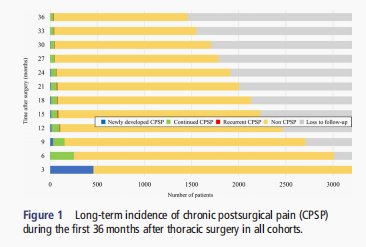
文章插图
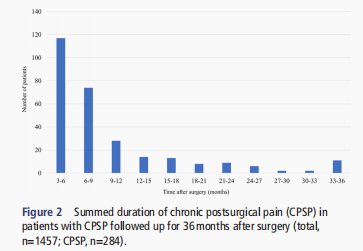
文章插图
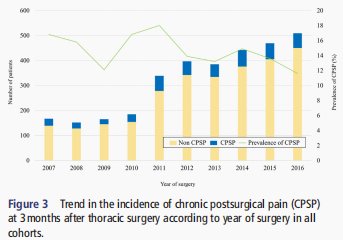
文章插图
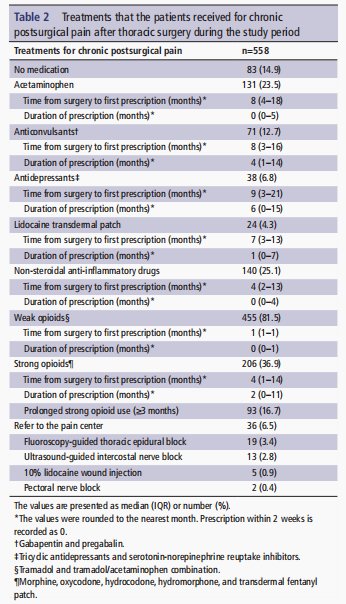
文章插图
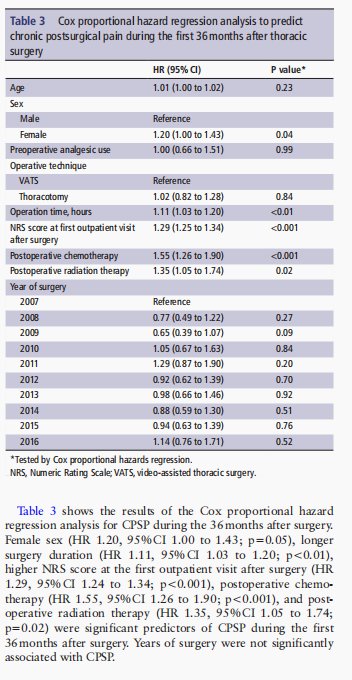
文章插图
4 结论
我们的研究显示胸外科术后CPSP的发生率以及延迟发作或复发有降低的趋势,能更好地了解胸部术后CPSP的进展,可为其预测和治疗提供重要信息。
原始文献来源 ?
Susie Yoon, Won-Pyo Hong, Hyundeok Joo, Hansol Kim, Samina Park,Jae-Hyon Bahk,Ho-Jin Lee.Long-term incidence of chronic postsurgical pain after thoracic surgery for lung cancer: a 10-year single-center retrospective study.Reg Anesth Pain Med 2020 05;45(5).DOI:10.1136/rapm-2020-101292.
英文原文
Long-term incidence of chronic postsurgical pain after thoracic surgery for lung cancer: a 10-year single-center retrospective study
Abstract
Background:The long-term incidence of chronic postsurgical pain (CPSP) after thoracic surgery has not yet been reported.
Methods:We retrospectively reviewed the electronic medical records of 4218 consecutive patients who underwent thoracic surgery for lung cancer between 2007 and 2016. We evaluated the long-term incidence of CPSP after thoracic surgery at intervals of 3 months for 36 months. A Cox proportional hazard regression analysis was performed to investigate the predictors of CPSP after thoracic surgery.
Result:A total of 3200 patients were included in the analysis. Of these, 459 (14.3%) and 558 (17.4%) patients were diagnosed with CPSP within 3 and 36 months after surgery, respectively. Furthermore, the incidence of CPSP decreased over time. Additionally, 99 (3.1%) patients were newly diagnosed with CPSP at least 6 months after surgery. Female sex (HR 1.20, 95% CI 1.00 to 1.43; p=0.04), longer duration of surgery (HR 1.11, 95% CI 1.03 to 1.20; p<0.01), higher 11-point Numeric Rating Scale score at first outpatient visit after surgery (HR 1.29, 95% CI 1.24 to 1.34; p<0.001), postoperative chemotherapy (HR 1.55, 95% CI 1.26 to 1.90; p<0.001), and postoperative radiation therapy (HR 1.35, 95% CI 1.05 to 1.74; p=0.02) were significant predictors of CPSP for 36 months after surgery.
- 疫苗|【992 | 速看】传播能力有所增强!有关奥密克戎变异株,最新解答来了!
- 血压|主动脉夹层可夺命?这五类人是高危人群,需高度重视
- 肺炎|遵义120教你肺炎伴胸膜炎怎么办
- 公司|罗欣药业:子公司注射用美罗培南通过仿制药一致性评价
- 相关|【中国实用外科杂志】肥胖代谢病合并甲状腺癌外科治疗中国专家共识(2021版)
- 范可尼|为什么会长白头发?
- 常崇旺|【视频回放】脑瘫患者常用外科术式及适应症
- 深圳|广东新增本土确诊病例9例:深圳2例、珠海5例、中山1例、梅州1例
- 痛风也可吃火锅 但注意少吃肉食
- 领导|邵阳召开强化新冠肺炎定点救治医院管理工作视频会议
